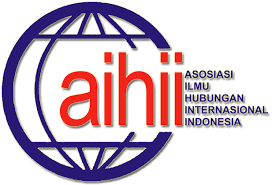Upaya Tiongkok untuk Menghidupkan Kembali Jalur Sutra dalam Perspektif Balance of Power
Abstract
China has regenerated the ancient Silk Road through the BRI (Belt and Road Initiative) scheme throughout the Middle East. The Chinese presence in the region has as well as the new hegemony, slowly shifting the position of the United States and its allies in the Middle East. The escalation of the conflict between Iran and Saudi Arabia does not make China supporting or denying both of them because China keeps the concept of non-intervention in the BRI scheme. The purpose of this study is to analyze the future of the Silk Road BRI by China in the Middle East by using the Balance of Power perspective, especially the Regional Security Complex overview. By conducting an in-depth literature study, the author finds that China is neither eternal friend nor a constant enemy of any Middle East countries. China relation with the countries of the region depends on the future situation. China can have good relations with Iran, Saudi Arabia, Israel, and Palestine at the same time. However, the relationship can change if the United States and some Middle East countries are making new alignment to obstruct China’s hegemony.
Downloads
References
Partowidagdo, W. (2014). Sejarah Penemuan Minyak di Dunia. [online] Migas ESDM. Dalam: https://migas.esdm.go.id/post/read/Sejarah-Penemuan-Minyak-di-Dunia [Diakses 26 Mei 2020].
Pratama, A. N. (2018). Berusia lebih dari 140 Tahun, Ini 6 Fakta Menarik Terusan Suez. Kompas, [online]. Dalam: https://internasional.kompas.com/read/2018/11/17/13212381/berusia-lebih-dari-140-tahun-ini-6-fakta-menarik-terusan-suez?page=2 [Diakses 20 Mei 2020].
R. Brawley, M. (2004). The Political Economy of Balance of Power Theory. Dalam: J. Levy, D. Lemke, M. R.Brawley, C. Layne, & J. J. all, Balance of Power: Theory and Practice in The 21st Century. Stanford: Stanford University Press., 76-102.
Sarwar, L. (2017). The Old Silk Road and the New Silk Road: An Analysis of the Changed Discourse. The Journal of Central Asian Studies, 24, 13-22.
Sheehan, M. (2000). The Balance of Power: History and Theory. New York: Routledge.
Sihbudi, R. (2007). Menyandera Timur Tengah. Jakarta: Mizan.
Smith, M. (2020). The Middle East’s other revolution: Tech trends from Morocco to Oman. [online] Wired. Dalam: https://wired.me/technology/middle-east-technology-trends-from-morocco-to-oman/ [Diakses 26 Mei 2020].
Suwaidi, J. S. (2018). UAE Society in The Twenty-first Century: Issues and Challenges in a Changing World. Abu Dhabi: UEA.
T.V. Paul. (2004). The Enduring Axioms of Balance of Power Theory and Their Contemporary Relevance. Dalam: Jack, Douglas, Mark, & J. dkk, Balance of Power : Theory and Practice in The 21st Century. California: Stanford University Press., 1-28.
Tobing, S. (2020). Naik-Turun Harga Minyak Setiap Terjadi Konflik di Timur Tengah. Kata Data, [online]. Dalam: https://katadata.co.id/berita/2020/01/09/naik-turun-harga-minyak-setiap-terjadi-konflik-di-timur-tengah [Diakses 25 Mei 2020].
Ulum, F. (2015). Sejarah Pemikiran Ekonomi Islam. Surabaya : IAIN Sunan Ampel & IDB.
Yang, S.-y. (2013). Power Transition, Balance of Power, and the Rise of China: A Theoretical Reflection about Rising Great Powers. The China Review, 13(2), 35-66.
Yu, W. (2018). Economic and Cultural Interactions between Israel and China. Dalam: Andrew, Sara, Yitzhak, & A. e. all, China’s Presence in the Middle East. New York: Routledge., 137-157.
Yulianti, D. dan Affandi, RMTN. (2018). Strategi Soft Power Dalam Ekspansi Ekonomi China Di Timur Tengah: Studi Kasus Kerjasama China-Iran. Mandala, 1(2), 247-265.
Xinhua.net. (2019). Palestinian PM lauds China's unwavering support to Palestinian cause. [online]. Dalam: http://www.xinhuanet.com/english/2019-09/24/c_138419182_2.htm [Diakses 25 Mei 2020].








